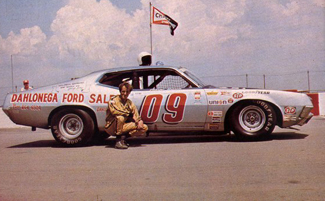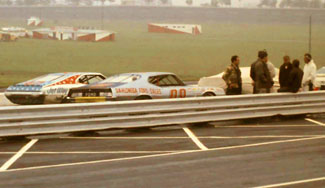
Georgia's Charles Barrett piloted this #09 Torino for George Elliott, father of current NASCAR driver Bill Elliott in 1973. Photo courtesy the Barrett Family
By Rick Minter-Guest Contributor
Posted in Feature Stories 2/18/11
For long-time NASCAR fans, the idea of seeing Bill Elliott in anything other than a No. 9 Ford or Mercury just doesn’t seem right.
But as Elliott begins the season in James Finch’s No. 09 Chevrolet, some things aren’t really new at all.
For starters, Elliott has driven Chevrolets before. He ran five races for Michael Waltrip Racing and one for Nelson Bowers in 2006, and he drove Roger Hamby’s Chevrolet for three races in 1979. He’s been in General Motors products as far back as 1978, when his team borrowed one of Benny Parsons’ Oldsmobiles for the second Atlanta race.
And Elliott’s new car number is a special one for his family. His late father George Elliott campaigned a No. 09 Ford in limited appearances from 1971 up until Bill started driving the No. 9 in 1975. Harry Gailey ran one race in Elliott’s No. 09, as did Jody Ridley and A.J. Reno. Charles Barrett, a North Georgia short tracker, had the most success in the No. 09 Ford. He raced it four times, with a best finish of 10th at Talladega in 1973.
Barrett, now retired in his home town of Cleveland, Ga., said that back then George Elliott wanted to run his favorite No. 9 in the elite NASCAR division, but that number had been assigned to another driver, likely Roy Tyner. So he chose the No. 09.
“I always ran the No. 11 on my short track cars, but it was George’s car and he was the boss, so we ran the 09,” Barrett said.
Barrett said the car, a Torino, was built by famed car builder Banjo Matthews in the mid-1960s, but its body was out of date. So Barrett put a 1971 Torino body on the car, using his usual short track methods.

Barrett brings the Elliott Torino up to speed at Atlanta in 1973. Photo courtesy John Betts
When he got to Talladega, he discovered just how important aerodynamics are at the giant track.
“I asked Glen Wood for some advice,” Barrett said. “He asked me who put the body on that car. I said, ‘I did.’”
Wood went on to point out that to run fast at Talladega all seams on the body need to be sealed so that air wouldn’t get up under the car.
“I worked on it and got it better, but Glen told me that the Torino wasn’t the body for Talladega. He said the Mercury like they had was much better,” Barrett said.
Just after that race started, a major crash occurred on the backstretch, and with 60 cars in the starting field the result was predictably ugly.
Barrett was among the few who emerged without major damage. He had only front spoiler damage.
“Somehow I got through it,” he said. “I remember seeing Cale Yarborough’s car up in the air. I could see the bottom of it as I drove by.”
Barrett also remembers seeing Wendell Scott’s crumpled No. 34 Mercury. “There wasn’t much left of his car,” he said. “And he had a pretty good car that day.”
The badly injured Scott never really recovered from the wreck and ran just one more Cup race before retiring.
After dodging The Big Wreck, Barrett pitted for fuel. When the rest of the leaders stopped, he cycled into the lead, which he held for nine laps. But he didn’t realize that he’d cut a tire driving through the debris.
George Elliott and the crew, noticing the tire was down, used their pit board to signal Barrett to pit. In the days before the team used radios, Barrett incorrectly assumed that his crew simply wanted to top off the tank.
“I wasn’t about to stop,” he said. “I was leading the race.”
But just as the cars restarted, Coo Coo Marlin pulled alongside with the news, and this time Barrett got the message.
“I’d never run a tire with an inner liner, and I didn’t know how it felt to have a flat,” he said.
Barrett made a pit stop, but the crew changed the wrong tire. By the time he made a second stop he was already two laps down. Still he finished 10th.

Barrett's car sits on pit road at Atlanta in 1973. Note the yellow 'rookie stripe' on the back bumper. Photo courtesy John Betts
He said his best outing, speed-wise, came in a race at Atlanta, where the team posted the ninth-fastest qualifying time overall but started 27th because the time was set on the second day of qualifying. Barrett said that his speed attracted the attention of lots of the circuit’s regulars, even if they were highly skeptical of the explanation.
“We took the motor out of the car that (George Elliott’s son) Dan was driving to high school and went to Atlanta and qualified with it,” Barrett said. “People asked me about it, and I told them that Ernie Elliott built it. Back then nobody knew who Ernie Elliott was.
“I don’t think they believed us anyway.”
The teen-ager’s power plant didn’t carry Barrett far into the race. He cracked a cylinder wall after three laps and finished 40th.
Just as he was getting started in NASCAR’s elite divisions, Barrett was involved in a highway crash while driving a wrecker. That crash that essentially ended his racing career.
Bill Elliott says that while he wasn’t really involved in his dad’s NASCAR racing back then, he does remember that his father had the right ideas about what it would take to succeed.
“He always bought good cars, he just didn’t have the resources to pull the whole deal together,” Bill Elliott said.
George Elliott kept buying proven equipment and relying on the racing savvy of his sons and his north Georgia neighbors. A decade or so after Barrett drove the No. 09 Fords, the dominant cars in NASCAR originated from the Elliott shops in Dawsonville.
And to many, that seemed as unlikely as posting the ninth best qualifying time for a Cup race with an engine from a teenager’s car.
Editor’s note: This story was originally published at Racin’ Today.com on January 21, 2011.
Rick Minter is an award-winning sports journalist who began covering motorsports for the The Atlanta Journal-Constitution in 1991, as well as serving as a bureau chief. Minter focused on racing exclusively from 2000-2008 . Minter and his wife Joanne live on the family farm in Inman, Georgia. In his spare time he collects and restores antique tractors and trucks.
Questions, comments, suggestions? Email us!
This website is not affiliated with or endorsed by the Georgia Racing Hall of Fame or the Georgia Auto Racing Hall of Fame Association, Inc. All content is the intellectual property of the individual authors. All opinions are those of the individual authors. Please do not repost images or text without permission.
